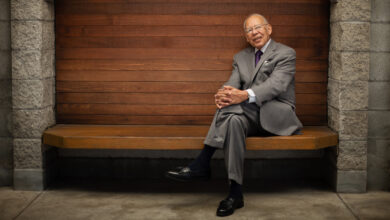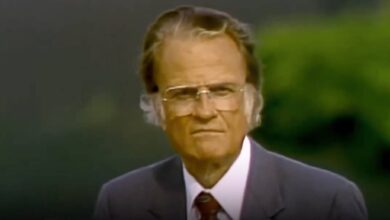Rites of Passage Can Help Boys Become Men

Twin crises afflict contemporary America: The Great Dechurching and The End of Men, as the titles of recent books label them. Put briefly: Many churches fail to lead young people into Christian maturity, while contemporary culture fails to bring boys into mature manhood.
We cannot solve either crisis without solving both, together. And we have resources for addressing these crises together—time-honored, transcultural resources attested in Scripture, manifested in the church, and affirmed by contemporary research into adolescent formation.
While “the great dechurching” is a crisis for girls as much as for boys, the overall challenges they face differ. As Richard Reeves shows, girls are outpacing boys in schools and, increasingly, in the workplace and in general health. American girls face challenges no less severe, but they are different.
In asking how all of us, especially our boys, can grow into Christian maturity, we should start by considering how our Lord left his boyhood behind in order to be about his Father’s business.
When Jesus was 12 years old, Luke’s gospel tells us, his family went to Jerusalem for the Festival of the Passover, as they did every year. “After the festival was over, while his parents were returning home, the boy Jesus stayed behind in Jerusalem” (Luke 2:41–43).
This is the sixth time Luke describes Jesus as either “the baby” or “the child”—he never calls him just plain “Jesus” up to this point. But then, at the end of the story, we read, “And Jesus grew in wisdom and stature, and in favor with God and man” (2:52, emphasis added).
Over the course of three days, Jesus leaves his boyhood behind. He does so through a rite of passage.
As Alfred van Gennep shows in his time-tested classic, rites of passage involve three stages. First, a boy is temporarily removed from the domestic family. Second, he is initiated into manhood through challenge, often with a funereal quality—the boy must die for the man to emerge. Finally, the emerging young man is assimilated into a group of peers and an adult vocation.
Jesus’s youthful temple visit bears the unmistakable marks of each stage.
After Jesus slips away from his parents, they travel a full day’s journey before they realize he is missing (evidently Mary and Joseph were not helicopter parents). They seek him “among their relatives and friends” before turning back to Jerusalem to look for him (vv. 44–45).
After three days, they finally find Jesus sitting in the temple courts “among the teachers, listening to them and asking them questions” (v. 46). Luke doesn’t tell us what Jesus has been eating or where he’s been sleeping, but there he is.
“Everyone who heard him was amazed at his understanding and his answers,” Luke writes. His parents were also “astonished”—and exasperated! His mother addresses him with a classic mixture of parental relief and frustration: “Son, why have you treated us like this? Your father and I have been anxiously searching for you” (vv. 47–48).
Jesus, for his part, seems surprised. “Why were you searching for me?” he asks. “Did you not know that I must be about My Father’s business?” (v. 49, NKJV). Although Jesus not so subtly reminds them of his divine paternity, this is not passive-aggressive preteen rebellion with a divine spin. He returns to Nazareth with them and “was obedient to them” (v. 51). He perfectly obeys, and he also slips away to be about his Father’s business in the temple.
And it is in being about his heavenly Father’s business that Jesus ceases to be a boy.
More specifically, he is initiated into his Father’s business through a rite of passage: He is removed from his domestic sphere, initiated into manhood through challenge and a kind of death, and then assimilated into an adult vocation and community.
The removal is obvious—this is the first time Jesus is separated from his parents in Luke’s gospel. The second stage, initiation into manhood through challenge, shows up in at least three ways.
First, Jesus spends three days in the big city fending for himself as a 12-year-old boy. Second, Mary and Joseph find Jesus participating in rabbinic discourse in the temple, essentially a form of intellectual combat. Imagine a 12-year-old wandering into a heated dispute in a seminary’s faculty lounge and jumping into the fray.
Most significantly, Luke frames the story as a foreshadowing of Christ’s death and resurrection. Throughout his gospel, Luke associates being lost with death and being found with life—Christ came “to seek and to save the lost” (19:10); the prodigal son “was dead and is alive again; he was lost and is found” (15:32). It is no coincidence that Jesus goes missing for three days in Jerusalem before being found alive. The boy has died. The young man is emerging.
Finally, Jesus is assimilated into a set of peers and an adult vocation. This brief story already points toward the major themes of his ministry. He is found amid the teachers of Scripture—he will be the authoritative teacher of Scripture. He is in the temple—he will eventually return both to cleanse it and to predict its destruction, because his flesh is the true temple, the dwelling place of God with man.
“I must be about My Father’s business.” The word translated as must here—“it is necessary”—is one of Luke’s favorites, usually communicating messianic necessity: “Was it not necessary that the Christ should suffer these things and enter into his glory?” (24:26, ESV). Being about his Father’s business leads Jesus slowly, surely, inevitably back to Jerusalem, where he will once again go missing in Jerusalem for three days before being found alive.
Removal. Initiation. Assimilation.
Practically every culture has ushered adolescent boys into emerging manhood through rites of passage. Not only Christ, but a host of Old Testament figures. Consider the stories of Jacob, Joseph, Moses, Samuel, and David—all feature removal, initiation through challenge, and assimilation. In fact, coming-of-age stories, both ancient and modern, often feature the same threefold pattern.
That’s because adolescence itself is a time of passage. Puberty removes a boy from his childhood, and he only exits adolescence when he has achieved some degree of settled adulthood. Rites of passage reflect these underlying realities, and they powerfully answer to the needs of adolescent formation.
The Roman Catholic theologian and educator Luigi Giussani says that, until adolescence, parents are handing on a tradition to their children—“an explanatory hypothesis of reality,” the meaning of life, and the shape of human flourishing. If mom and dad tell their five-year-old child one thing and the whole world says something else, mom and dad tend to win out.
This is not the case with a 15-year-old, as most parents know. That’s because, as Giussani puts it, adolescents are testing this tradition. Parenting adolescents is stressful because adolescents are quite literally “stress testing” the parental hypothesis. They’re asking, “Is it true? Does it work?” Parental answers no longer suffice, because it is precisely those answers that are being tested.
During adolescence, parental words matter less than parental examples. Do parents live up to their words? And parental words begin to matter less than those of peers and nonparental adult mentors, who, along with the broader culture, constitute the testing ground that will either confirm or deny the parental hypothesis. The upshot is that parents (and churches and schools) have a deepening responsibility to curate their adolescents’ context—by deciding on churches, youth groups, schools, extracurriculars, and so forth.
But there is a Catch-22. Just when it is more important than ever to curate context, it is likewise critical to give adolescents more independence, responsibility, and freedom than ever before, and for the same reason—an adolescent is moving out of the home and into the world. Parents must let their children test the hypothesis in order to leave childhood behind.
Giussani says failing to test the hypothesis in adolescence results in one of two outcomes: either an uncritical fundamentalism or an uncritical cynicism. Having failed to test the tradition’s worth, one either clings to it blindly, immaturely, fearfully—or one blindly, immaturely, and angrily rejects the tradition, refusing to consider its claims at all.
Successfully testing the tradition requires maximal curation of context and maximal independence—at one and the same time. American society gives teenagers neither. We are perhaps the first culture in world history in which a 17-year-old boy’s daily routine and responsibilities are more like that of his 11-year-old little brother than his 20-year-old brother who is off at college or working and living independently. The exception—the one way in which we practice “free-range parenting”—is in giving our youth free reign to digitally explore our incoherent if not malignant culture.
To riff on a common line in educational circles, our culture is perfectly designed to achieve the results we are getting. Our challenge, collectively, is to restore the conditions necessary for healthy adolescent formation.
The answer for boys rests in part on recovering traditional rites of passage. When we consciously remove a boy from the domestic sphere, purposefully separating him from his childhood; when we initiate him into manhood through challenge; when we assimilate him into an adult vocation and community—we are honoring the givenness of his adolescent development.
This is possible but not easy. Honoring rites of passages means giving emerging young men adult responsibilities and adult consequences. Responsibility requires risk.
It also requires a mature adult community. Like any liturgy, rites of passage are effective only insofar as they reflect reality and are authorized by a community. This is perhaps the greatest challenge, because no family can do it alone. Boys and girls alike need real Christian community and real Christian culture.
Every family, every church, and every school must consider how to incorporate these principles. At the boarding school I am helping to launch, we invite high school boys to live alongside faculty families under a temporary rule of digital poverty. Our curriculum pairs an education in the classics with small-scale agriculture and skilled trades—an embodied formation with real work and the responsibility that comes from growing your own food and building your own buildings.
We chose our rural 176-acre campus to give boys freedom to explore God’s good creation and as a fitting setting for the challenges of strength and endurance that come from hiking the Blue Ridge Mountains, playing rugby, and splitting the wood that will warm them through the winter. We plan to build a beautiful chapel at the heart of campus to order our lives—literally and symbolically—around the life of the church.
Ultimately, rites of passage foreshadow, anticipate, and echo the true rite of passage: baptism. The baptismal liturgy in the Book of Common Prayer specifies that, just before baptizing, “the Minister shall take the Child into his arms.” The child is thus removed from the literal arms of the domestic family before being initiated into God’s family by being “buried with Christ” in baptism and raised to walk in “newness of life.” After baptism, the minister declares, “We receive this Child into the congregation of Christ’s flock.”
The gathered community, standing and facing the baptismal font, is exhorted to pray “that this Child may lead the rest of his life according to this beginning,” which means living out in daily life the reality of initiation into the family of God—taking up one’s cross daily, crucifying the flesh and its affections, and living in holiness through ever-deepening conversions into Christ.
We can only invite our children into such a life if we ourselves exhibit the life of Christ individually and communally. We must be about our Father’s business. We must increase in wisdom and in favor with God and man. As we grow into full maturity as Christian men and women—“unto the measure of the stature of the fulness of Christ” (Eph. 4:13, KJV)—we must do so together in community.
Mark Perkins is chaplain and assistant headmaster of St. Dunstan’s Academy in Roseland, Virginia.




